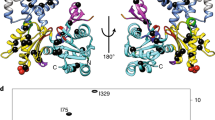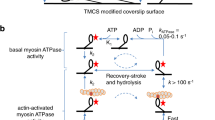Abstract
The conformational changes in myosin associated with ADP release and their influence on actin sliding velocity are not understood. Following actin binding, the myosin active site is in equilibrium between a closed and open ADP bound state, with the open state previously thought to favor ADP release and thus expected to be favored in faster myosins. However, our recent work with a variety of myosins suggests the opposite, that the open conformation is dominant in slower myosins, which have higher ADP affinities. To test if this correlation holds for fast myosin isoforms, we determined the relationships between conformational pocket dynamics, ADP affinity and velocity of four Drosophila myosins: indirect flight muscle (IFM) myosin (IFI), embryonic muscle myosin (EMB) and two IFI/EMB chimeras. Electron paramagnetic resonance spectra of nucleotide-analog spin probes (SLADP) bound to IFI subfragment-1 in the absence of actin showed a high degree of immobilization, indicating a predominately closed nucleotide pocket. The A·M·SLADP spectra of all four myosins in fibers (actin bound) also indicated an equilibrium favoring the closed conformation with the closed state closing even further. However, the energetics of pocket closure did not correlate with Drosophila myosin actin velocity suggesting our previous model relating pocket dynamics to velocity does not hold for fast myosin isoforms. We conclude that for these fast myosins, and possibly other fast myosins, velocity is controlled by factors other than the ratio of open to closed nucleotide pocket conformation.



Similar content being viewed by others
References
Alessi DR, Corrie JE, Fajer PG, Ferenczi MA, Thomas DD, Trayer IP, Trentham DR (1992) Synthesis and properties of a conformationally restricted spin-labeled analog of ATP and its interaction with myosin and skeletal muscle. Biochemistry 31:8043–8054
Cooke R (1990) Force generation in muscle. Curr Opin Cell Biol 2:62–66
Cripps RM, Bernstein SI (2000) Generation of transgenic Drosophila melanogaster by P element-mediated germline transformation. In: Norton PA, Steel LF (eds) Introducing DNA into living cells and organisms. Eaton Publishing, Natick, pp 93–125
Crowder MS, Cooke R (1987) Orientation of spin-labeled nucleotides bound to myosin in glycerinated muscle fibers. Biophys J 51:323–333
Griffith OH, Jost PC (1976) In: Berliner LJ (ed) Spin labeling theory and applications. Academic Press, New York, pp 454–523
Higashi-Fujime S, Ishikawa R, Iwasawa H, Kagami O, Kurimoto E, Kohama K, Hozumi T (1995) The fastest actin-based motor protein from the green algae, Chara, and its distinct mode of interaction with actin. FEBS Lett 375:151–154
Inoue A, Saito J, Ikebe R, Ikebe M (2002) Myosin-IXb is a single-headed minus-end-directed processive motor. Nat Cell Biol 4:302–306
Kull FJ, Sablin EP, Lau R, Fletterick RJ, Vale RD (1996) Crystal structure of the kinesin motor domain reveals a structural similarity to myosin. Nature 380:550–555
Miller BM, Nyitrai M, Bernstein SI, Geeves MA (2003) Kinetic analysis of Drosophila muscle myosin isoforms suggests a novel mode of mechanochemical coupling. J Biol Chem 278:50293–50300
Miller BM, Zhang S, Suggs JA, Swank DM, Littlefield KP, Knowles AF, Bernstein SI (2005) An alternative domain near the nucleotide-binding site of Drosophila muscle myosin affects ATPase kinetics. J Mol Biol 353:14–25
Miller BM, Bloemink MJ, Nyitrai M, Bernstein SI, Geeves MA (2007) A variable domain near the ATP-binding site in Drosophila muscle myosin is part of the communication pathway between the nucleotide and actin-binding sites. J Mol Biol 368:1051–1066
Naber N, Rice S, Matuska M, Vale RD, Cooke R, Pate E (2003) EPR spectroscopy shows a microtubule-dependent conformational change in the kinesin switch 1 domain. Biophys J 84:3190–3196
Naber N, Purcell TJ, Pate E, Cooke R (2007) Dynamics of the nucleotide pocket of myosin measured by spin-labeled nucleotides. Biophys J 92:172–184
Naber N, Malnasi-Csizmadia A, Purcell TJ, Cooke R, Pate E (2010) Combining EPR with fluorescence spectroscopy to monitor conformational changes at the myosin nucleotide pocket. J Mol Biol 396:937–948
Naber N, Cooke R, Pate E (2011) Conformational changes at the nucleotide pocket of motor proteins monitored by electron paramagnetic resonance spectroscopy. Pure Appl Chem 83:1675–1684
Nordio PL (1976) General magnetic resonance theory. In: Berliner LJ (ed) Spin labeling theory and applications. Academic Press, New York, pp 5–52
Nyitrai M, Rossi R, Adamek N, Pellegrino MA, Bottinelli R, Geeves MA (2006) What limits the velocity of fast-skeletal muscle contraction in mammals? J Mol Biol 355:432–442
Post PL, Tyska MJ, O’Connell CB, Johung K, Hayward A, Mooseker MS (2002) Myosin-IXb is a single-headed and processive motor. J Biol Chem 277:11679–11683
Purcell TJ, Naber N, Franks-Skiba K, Dunn AR, Eldred CC, Berger CL, Malnasi-Csizmadia A, Spudich JA, Swank DM, Pate E, Cooke R (2011a) Nucleotide pocket thermodynamics measured by EPR reveal how energy partitioning relates myosin speed to efficiency. J Mol Biol 407:79–91
Purcell TJ, Naber N, Sutton S, Cooke R, Pate E (2011b) EPR spectra and molecular dynamics agree that the nucleotide pocket of myosin V is closed and that it opens on binding actin. J Mol Biol 411:16–26
Sablin EP, Kull FJ, Cooke R, Vale RD, Fletterick RJ (1996) Crystal structure of the motor domain of the kinesin-related motor ncd. Nature 380:555–559
Siemankowski RF, Wiseman MO, White HD (1985) ADP dissociation from actomyosin subfragment 1 is sufficiently slow to limit the unloaded shortening velocity in vertebrate muscle. Proc Natl Acad Sci USA 82:658–662
Silva R, Sparrow JC, Geeves MA (2003) Isolation and kinetic characterisation of myosin and myosin S1 from the Drosophila indirect flight muscles. J Muscle Res Cell Motil 24:489–498
Sindelar CV, Budny MJ, Rice S, Naber N, Fletterick R, Cooke R (2002) Two conformations in the human kinesin power stroke defined by X-ray crystallography and EPR spectroscopy. Nat Struct Biol 9:844–848
Sun M, Oakes JL, Ananthanarayanan SK, Hawley KH, Tsien RY, Adams SR, Yengo CM (2006) Dynamics of the upper 50-kDa domain of myosin V examined with fluorescence resonance energy transfer. J Biol Chem 281:5711–5717
Swank DM (2012) Mechanical analysis of Drosophila indirect flight and jump muscles. Methods 56:69–77
Swank DM, Wells L, Kronert WA, Morrill GE, Bernstein SI (2000) Determining structure/function relationships for sarcomeric myosin heavy chain by genetic and transgenic manipulation of Drosophila. Microsc Res Tech 50:430–442
Swank DM, Knowles AF, Suggs JA, Sarsoza F, Lee A, Maughan DW, Bernstein SI (2002) The myosin converter domain modulates muscle performance. Nat Cell Biol 4:312–316
Swank DM, Knowles AF, Kronert WA, Suggs JA, Morrill GE, Nikkhoy M, Manipon GG, Bernstein SI (2003) Variable N-terminal regions of muscle myosin heavy chain modulate ATPase rate and actin sliding velocity. J Biol Chem 278:17475–17482
Swank DM, Kronert WA, Bernstein SI, Maughan DW (2004) Alternative N-terminal regions of Drosophila myosin heavy chain tune muscle kinetics for optimal power output. Biophys J 87:1805–1814
Swank DM, Vishnudas VK, Maughan DW (2006) An exceptionally fast actomyosin reaction powers insect flight muscle. Proc Natl Acad Sci USA 103:17543–17547
Sweeney HL, Houdusse A (2010) Structural and functional insights into the myosin motor mechanism. Annu Rev Biophys 39:539–557
Weiss S, Rossi R, Pellegrino MA, Bottinelli R, Geeves MA (2001) Differing ADP release rates from myosin heavy chain isoforms define the shortening velocity of skeletal muscle fibers. J Biol Chem 276:45902–45908
Wells L, Edwards KA, Bernstein SI (1996) Myosin heavy chain isoforms regulate muscle function but not myofibril assembly. EMBO J 15:4454–4459
Yang C, Kaplan C, Thatcher M, Swank DM (2010) The influence of myosin converter and relay domains on cross-bridge kinetics of Drosophila indirect flight muscle. Biophys J 99:1546–1555
Acknowledgments
This work was supported by National Instates of Health grants AR042895 (R.C., N.N.), AR053720 (E.P., N.N.), and AR055611 (D.S.).
Author information
Authors and Affiliations
Corresponding author
Rights and permissions
About this article
Cite this article
Eldred, C.C., Naber, N., Pate, E. et al. Conformational changes at the nucleotide site in the presence of bound ADP do not set the velocity of fast Drosophila myosins. J Muscle Res Cell Motil 34, 35–42 (2013). https://doi.org/10.1007/s10974-012-9331-8
Received:
Accepted:
Published:
Issue Date:
DOI: https://doi.org/10.1007/s10974-012-9331-8




